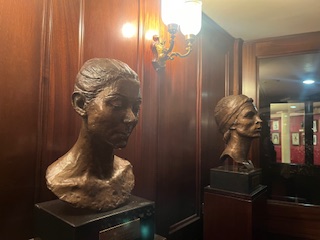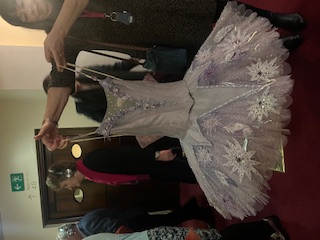February 15th 2024
What a treat this visit was! 21 of us gathered (including a few Masters) and, as we entered we were immediately ‘in the space’ so to speak with rehearsals going on in the foyer led by the playing of a piano. Our guide was well-informed and enthusiastic and introduced us to the history of the Opera House with models, paintings and sculptures. The current Opera House is the fourth version. The original was built in 1732 by John Rich as a theatre, from the fortune he gained from the Beggars Opera, and it benefited from a long-term association with Handel which triggered opera performances. It was burnt down twice in 1808 and1856 and rescued, after the last fire, by Queen Victoria who, with Prince Albert used to attend 4 nights a week. The name Royal Opera House was given in 1892 and during the two world wars it served as a furniture store and Mecca Dance Hall. Its rescue began after WW2, and the embryo Covent Garden Opera teamed up with Sadlers Wells Ballet. Eventually both companies were awarded royal charters – Royal Ballet in 1956 and Royal Opera in 1968. By the year 2000 the theatre had been completely transformed with the iron Floral Hall renovated, and its size increased so the original theatre occupies only a quarter of what’s there now. The auditorium itself remained, but well over half of the complex is new.
The operation is huge in every way – in terms of space, performances, logistics, stages, employees (1000)–everything. It is the largest in the world. We had a marvellous opportunity to get glimpses of the scale of it. From the seats high up in the auditorium, with its perfect acoustics (no microphones), we saw electricians on stage sorting out the lighting – there must have been about 15 of them- using the computer controlled fly-bar system. We heard that there were 9 sliding platforms within the stage, which could bring scenery in and out easily, which helps explain why a number of different productions can be performed in a day and multiple productions in a week, and 40 different productions in a year. Ballet scenery is displayed around
the stage edges as the floor is needed for the dancing, opera is less constrained. We heard about the flexibility of the orchestra in providing the right instruments and number of performers, with special moving platforms to shift pianos – 2 are sometimes needed. Everything works like clockwork and is thoroughly worked -hrough. The production process starts with schematic models then digital models with lights checked out, followed by the final design. The sets are built in Essex, as well as the costumes. Ballet has well-defined choreography but opera has greater interpretative freedom for the sets. Everything is worked out18months ahead of the show.
We saw and held costumes – exquisitely made tutus which are designed with 9 layers of tuille and a separate basque, so they can be easily altered. They are designed to last around 2 years, and are mainly made in Essex – the home of the costume museum. We walked through what seemed like rabbit warrens of stored costumes, having been cleaned after each performance. After the final performance, they are stored in ozone, before being finally stored in large containers with the scenery, and moved around with a lift the size of a lorry, after which they are transported to Wales for longer term storage. And as we wandered the warrens of storage we came to a large window where we could view dancers rehearsing in an area that was the same size as the stage, and handle ballet shoes (which normally last one day). What an absolute delight all that was, and a privilege to see these beautiful graceful, elegant dancers up close. There are set routines for rehearsal and strict regimes for preparation before a performance including rehearsal, make up, warm up and down time after the performance to cool down and re-equilibrate. It made one feel tired listening to how much had to be done before the dancers even go on stage!
And then a lovely, animated lunch catching up with each other. Everyone seemed to have thoroughly enjoyed the visit with a few comments about now understanding why the price of the tickets are so high.
It was really great to experience.













Comments